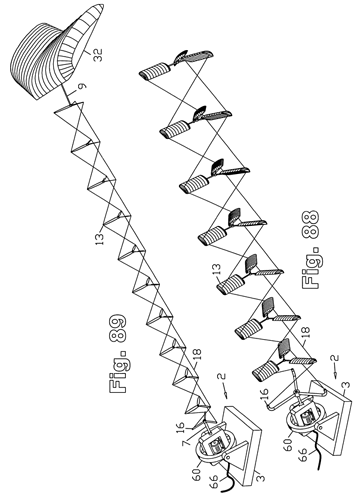That is the problem. “I just looked…” : we must take the time to think first. An analysis of a patent is not looking at an image.
This patent, like almost patents, contains an independent claim followed by dependent claims.
The independent claim is about the integration of turbines in a sail within a same plane. The claim 9 works with the figure 9, and is a dependent claim that is connected to the independent claim 1.
The figure 9 represents a device where the first turbine is integrated in the kite, unlike the device of which you provide the video. A picture is not enough, not even the essential: reading the text. The figure 8 represents turbines integrated in the kite, as for claim 1 and other claims, unlike the device on your video, a time again.
Pictures and concepts are not the same. Patents are about concepts.
I precise also it was a French patent, written in French language.
However there are elements I quoted in this patent, concerning a prior art from you, from Dave Santos, and also from @dougselsam, not in regard to the embodiment 1, but in regard to the embodiment 3, concerning the implementation of an arch and the ground installation. I provide the Google translation (with some mistakes) from French language of the concerned extract below from the link you provided:
" According to a third preferred embodiment for the massive exploitation of high winds and high altitude, the assembly (1) is part of a type of arch kite (1, 15), forming its summit, strings (5, 6) are fixed to the pivot (7) located in the middle of the area defined by a circular rail (12) allowing the orientation of the arch (1, 15) according to wind direction 25 and drawn and designed by Roderick Read the association “KitePower”. Dave Santos at “KiteLab” and the association “KitePower” student airborne energy systems, described and performed under the name of “Mothra” power arches enabling high stability and high lift capacity and capable be carried out at all levels, constituting a breakthrough in basic architecture of airborne wind turbine 30 as having the potential of a wind farm on rounds, with one set of great lightness. Both ends of the arch are attached to the circular rail (12) .Chacune the ends of the arch (1, 15) is attached to a winch (14) provided by the applicant, each winch (14) being attached to a shoe (13) recessed downwards and thus sliding away from supports (19) 35 the two winches (14) wind and unwind the two respective ends of the arch, particularly during take-off and return operations in order to clarification of the operating zone, the turbine (3) taking off as a helicopter as 3,025,006 for other 5 embodiments, their generators working as an electric motor. The electricity is routed by the strings (5 and 6) _ as for other embodiments or (16) or by legs (15) of the arche.Les strings (5, 6) can also be deleted when the assembly (1) is integrated to the arch (1, 15)."
This patent is also available on Espacenet - Données bibliographiques.
Below is a video summarizing this patent. It begins with a kite comprising an integrated turbine, as for the embodiment 1, and finishes with an arch as embodiment 3. You can also read the text mentioning Dave Santos’ contribution.
So, your…
…only proves that you have not read this patent and particularly the extract I quote above.
Moreover as you mention it is not more a valid patent. So …
…So this remark is misplaced, a time again, and is also a nonsense, since there is no more right connected to this patent. I have other withdrawn patents: I guess you are interested by them today.
I don’t believe you are suddenly interested in my old or recent patents for pure intentions. Are you embarrassed by the questions I ask (without serious reply from you) about your system as on Network Kites and Daisy network kite rotors - #37 by PierreB?
In the other hand Doug’s US6616402 is a valid patent. Doug built central shaft versions of Serpentine, but also conceived a TRPT WIDE version of SuperTurbine ™, without central shaft. See the figure 88 below.
What you call as Daisy is SuperTurbine ™ from a valid patent. You claim Daisy is the first hollow stacked ring kites. In fact I saw some transverse thin rods between the blades. On the drawing above the rods are thicker: it is a tiny difference as there is also spacing between these blades.
But be quiet: Doug will not ask you some royalties. Generally patents prevent business, but not building for experiments. And I guess Doug is rather happy you build his TRPT SuperTurbine ™ version.
By the same in a similar way as everyone filling patents I can be inspired by previous concepts, trying (sometimes with success for the novelty, sometimes no due to the huge prior art I don’t know, leading to the value of the patent search report) to make something new and workable from what is known.
And also: nobody has still find a workable design-concept at utility scale. I think a successful design can be something similar to known designs, with a tinier difference than that between the devices on your 2012 arch video and on my figure 9, although a higher difference than that between what you call Daisy and the TRPT SuperTurbine ™ fig. 88 version.
